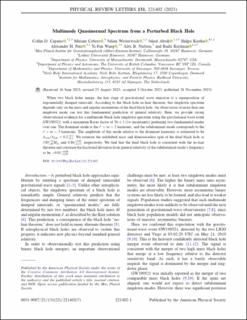| dc.contributor.author | Capano, Collin D. | |
| dc.contributor.author | Cabero, Miriam | |
| dc.contributor.author | Westerweck, Julian | |
| dc.contributor.author | Abedi, Jahed | |
| dc.contributor.author | Kastha, Shilpa | |
| dc.contributor.author | Nitz, Alexander H. | |
| dc.contributor.author | Wang, Yi-Fan | |
| dc.contributor.author | Nielsen, Alex Bentley | |
| dc.contributor.author | Krishnan, Badri | |
| dc.date.accessioned | 2024-03-14T09:45:47Z | |
| dc.date.available | 2024-03-14T09:45:47Z | |
| dc.date.created | 2023-12-11T10:16:46Z | |
| dc.date.issued | 2023 | |
| dc.identifier.citation | Capano, C. D., Cabero, M., Westerweck, J., Abedi, J., Kastha, S., Nitz, A. H., ... & Krishnan, B. (2023). Multimode Quasinormal Spectrum from a Perturbed Black Hole. Physical Review Letters, 131(22), 221402. | en_US |
| dc.identifier.issn | 0031-9007 | |
| dc.identifier.uri | https://hdl.handle.net/11250/3122339 | |
| dc.description.abstract | When two black holes merge, the late stage of gravitational wave emission is a superposition of exponentially damped sinusoids. According to the black hole no-hair theorem, this ringdown spectrum depends only on the mass and angular momentum of the final black hole. An observation of more than one ringdown mode can test this fundamental prediction of general relativity. Here, we provide strong observational evidence for a multimode black hole ringdown spectrum using the gravitational wave event GW190521, with a maximum Bayes factor of 56 +/- 1 (1 sigma uncertainty) preferring two fundamental modes over one. The dominant mode is the l = m = 2 harmonic, and the subdominant mode corresponds to the l = m = 3 harmonic. The amplitude of this mode relative to the dominant harmonic is estimated to be A(330)/A(220) = 0.2(-0.1)(+0.2). We estimate the redshifted mass and dimensionless spin of the final black hole as 330-40(+30) M-circle dot and 0.86(-0.11)(+0.06) -0.11, respectively. We find that the final black hole is consistent with the no-hair theorem and constrain the fractional deviation from general relativity of the subdominant mode's frequency to be -0.01(-0.09)(+0.08). | en_US |
| dc.language.iso | eng | en_US |
| dc.publisher | American Physical Society | en_US |
| dc.rights | Navngivelse 4.0 Internasjonal | * |
| dc.rights.uri | http://creativecommons.org/licenses/by/4.0/deed.no | * |
| dc.title | Multimode Quasinormal Spectrum from a Perturbed Black Hole | en_US |
| dc.type | Peer reviewed | en_US |
| dc.type | Journal article | en_US |
| dc.description.version | publishedVersion | en_US |
| dc.rights.holder | The authors | en_US |
| dc.subject.nsi | VDP::Matematikk og Naturvitenskap: 400::Fysikk: 430::Astrofysikk, astronomi: 438 | en_US |
| dc.source.volume | 131 | en_US |
| dc.source.journal | Physical Review Letters | en_US |
| dc.identifier.doi | 10.1103/PhysRevLett.131.221402 | |
| dc.identifier.cristin | 2211580 | |
| dc.relation.project | Norges forskningsråd: 302640 | en_US |
| cristin.ispublished | true | |
| cristin.fulltext | original | |
| cristin.qualitycode | 2 | |

